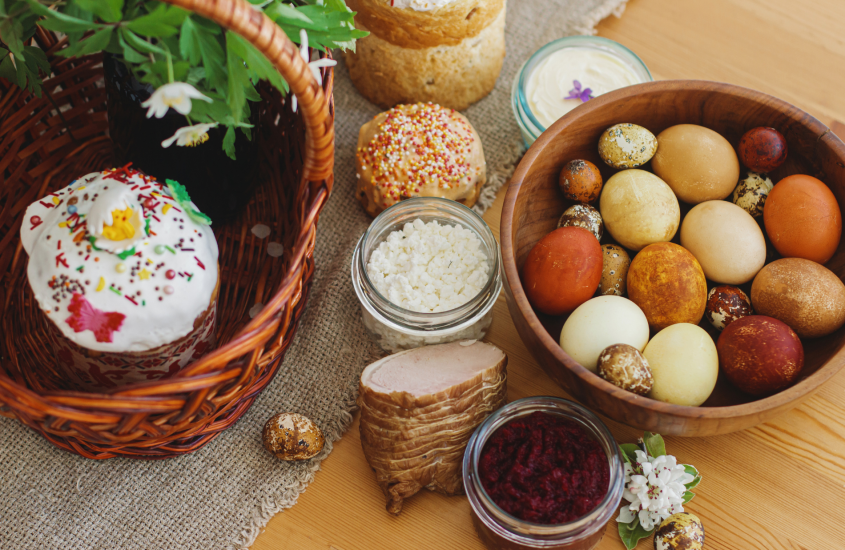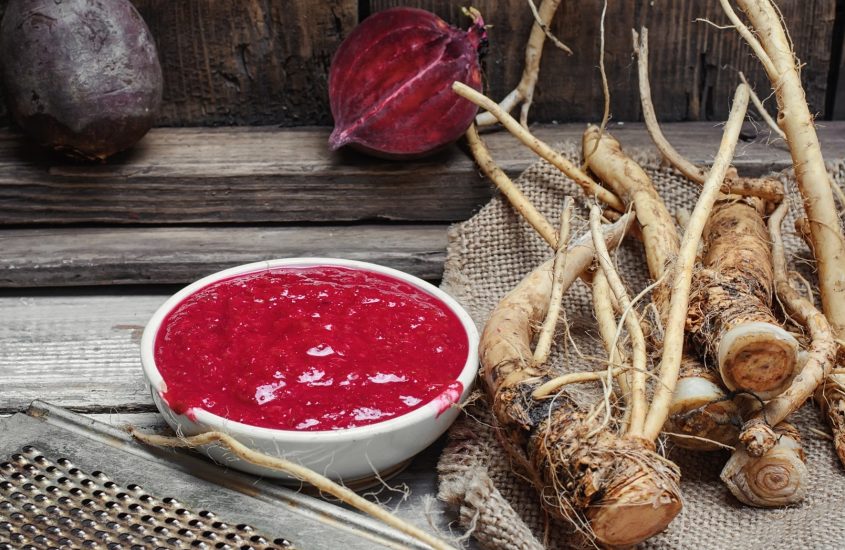Ukrainian Easter Breakfast

The Ukrainian Easter Breakfast, Великодній сніданок, is a cherished tradition steeped in cultural significance and familial warmth. Just as the Holy Supper features the 12 Fasting Dishes, commemorating the birth of Jesus Christ, the Easter breakfast is a celebration of renewal and resurrection. Families come together on this joyous morning to partake in a spread of traditional dishes, each rich in symbolism and flavour.
While there are customary staples, the menu is flexible, allowing hosts to infuse their own preferences and regional influences. Join us on a journey through the flavours, traditions, and stories that make the Великодній сніданок a beloved part of Ukrainian cultural heritage.

Contents

1. Setting the Table
Як накривати стіл до Великодня
It is customary to only set the Easter table when you are in a good mood. Traditionally, Ukrainians would embroider a new table cloth which was typically all white. Easter Rushnyks, taken from the consecrated Easter Baskets, are then spread on top of the table. Other decorations can include pussy willow and Pysanky eggs. The breakfast begins with a prayer or thanksgiving for the previous year.
Please note: In general, the main dishes of the Easter Breakfast are Paska, dairy produce, and meat dishes. All others can change, as each family have their own ceremonial dishes dependent on regional or even family traditions.

Easter Bread | Паска
The most important dish on the festive table is the homemade Paska bread. You can decorate it with various confectionery decorations, chocolate drops or nuts. This is a symbol of the Resurrection. This is a sacred bread, which also symbolizes spiritual nourishment.

Following a prayer, the Paska is shared among family to begin the breakfast: from the oldest member to the youngest. In some oblasts, the Paska is broken off and whoever breaks off the biggest piece will be lucky throughout the upcoming year.
There are two types of Easter bread in Ukraine. The first, which is known as Paska, is round like the sun and decorated with religious symbols made from the dough. The other is a tall, cylindrical shape which is usually topped with icing and sprinkles, and is commonly referred to as Babka.

Krashanky | Крашанки
In other regions Krashanky eggs are eaten first during the breakfast, rather than Paska. The eggs are completely edible as they are dyed with natural foods, such as onions, to achieve their distinctive red colour. This red symbolises Christ’s blood.

Dairy Products | Молочні продукти
Dairy products are a staple on the Easter Breakfast table. They symbolise the connection between people and Jesus Christ. Just as a child receives life, strength and energy from milk, so Christians are enriched with holy energy from Jesus.
The dairy dishes usually consist of cheese or butter, but in more recent years they have evolved to represent more western aspects of Easter. One example of this is the Easter Lamb, which can either be in a baked form or cut out of cheese.

Сирна паска (cheese Paska) is a dairy variant of the traditional Paska, which you may have heard of. This is a traditional cheese dish which is prepared for the Easter holiday. The truncated pyramid shape represents the tomb where the resurrection of Christ took place, which is why the letters “ХВ” are inscribed on the side – «Христос Воскрес!» (Christ has Risen). Despite also going by the name Paska, this one is not taken in the basket to Church, and instead enjoyed at home.

Meat Dishes | М’ясні страви
The tradition of incorporating meat items into an Easter basket finds its roots in the Old Testament, where the sacrificial lamb signifies the conclusion of Lent. The selection of meat typically varies based on regional preferences, as long as whatever is chosen has no trace of blood.

Sausage (Ковбаса): Sausages typically remind us of God’s favour and generosity. Sausages can typically be found on the Easter table in central Ukraine, alongside a baked Ham (Шинка).
Baked cockerel (Запечений півень): In Western Ukraine, a roasted rooster is eaten at the Breakfast, symbolising the first roosters that announced the Resurrection of Jesus Christ.

Beetroot with horseradish | Бурячки з хроном
Grating the root of horseradish into a bowl is a customary practice, which is often combined with grated beetroots. The bitterness of the horseradish represents Christ’s suffering and Crucifixion, while the sweet flavour of beets symbolise his Resurrection and the sweetness of everlasting life.

Salt | Сіль
Salt is highly symbolic across Ukrainian culture and often considered an important talisman. You may have even heard of the ancient Ukrainian welcome still continued today, which consists of bread and salt. The salt used in the Easter Basket is placed on the Easter table, to remind us that we are salt of the Earth.

Did you enjoy this post?
We hope you enjoyed learning about the dishes of the Ukrainian Easter Breakfast. We’d love to hear about the dishes you prepare for your own Easter celebration.
Make sure you share your culinary traditions, and connect with us on social media. Wishing you a joyous and meaningful celebration. Христос воскрес!


















